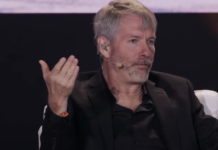
Earn a free on-chain certificate touting your knowledge of Ethereum by taking Decrypt U’s free course, Getting Started with Ethereum.
As of September 2023, Ethereum is the second-largest cryptocurrency in the world by total value, with a market capitalization of over $229 billion. Despite the fact that Ethereum’s value is lower than that of rival Bitcoin, though, there is a good argument to be made that Ethereum is more important for the crypto and blockchain spaces overall than its larger competitor. Since its launch in 2015, the Ethereum network has been instrumental in powering the next generation of decentralized applications (dApps) and, more recently, the world of decentralized finance (DeFi) more broadly.
This is thanks to Ethereum’s powerful smart contracts capabilities and versatility. As of March 2023, protocols built using the Ethereum network were responsible for about 90%, or $90 billion, of the total value locked in DeFi.
Just as Ethereum is a critical component of the crypto world and one that has shaped the development of the industry since its launch, the network’s founder Vitalik Buterin is similarly influential. The Russian-Canadian programmer and writer—who is not yet 30 years old as of this writing—is arguably the single most famous individual in the world of cryptocurrency today (another prime candidate for this title, Bitcoin founder Satoshi Nakamoto, is a pseudonymous name potentially representing more than one real person). Who is Vitalik Buterin, and how did he come to create Ethereum?
Early Interests Led to Crypto
Buterin was born in Russia but moved to Canada at a young age, where he was quickly recognized for his strong abilities in math. His earliest experiences with programming and crypto came at home, as his father was a computer scientist. Notably, Buterin’s early experience with the massively multiplayer online role-playing game World of Warcraft may have contributed to his desire to work outside of the traditional, centralized economics space: although a devoted player, he quit the game when developers made a change to the rules that he disagreed with.
Through high school and into college, Buterin honed his programming abilities and connected with influential mentors like the cryptographer Ian Goldberg, known for his involvement with the Tor Project among other things. It was during this time that he also first learned of Bitcoin, in 2011. Buterin wrote blog articles on cryptocurrency to earn his first BTC, eventually co-founding and contributing to Bitcoin Magazine.
College Years and Ethereum Origins
As a student at the University of Waterloo, Buterin assisted Goldberg until his work in cryptocurrency began to take up a substantial portion of his time. At this stage, he left university to travel the world for several months to connect with Bitcoin developers. This experience was crucial to Buterin’s development of the Ethereum model, as he felt that the developers he met were all too concerned with specific uses for cryptocurrency. Buterin came to believe that the next generation of blockchain systems should be more versatile and broader.
Buterin’s interest in broadening Bitcoin’s scope led him to pursue a Turing-complete programming language to realize his vision. The young programmer created an initial white paper for this concept, which he called Ethereum, in 2013. Venture capitalist Peter Thiel’s eponymous Fellowship awarded Buterin a grant of $100,000 in 2014, allowing him to fully focus his efforts on developing the new ecosystem.
Between Buterin’s initial white paper in 2013 and Ethereum’s eventual launch many months later, the vision developed to encompass much more than just a digital currency, adding ideas about smart contracts, decentralized applications, and decentralized autonomous organizations (DAOs) as well. By early 2014, Buterin was ready to share this wider concept with the crypto community, and he formally announced the project in January. An initial coin offering followed, raising about $18 million worth of BTC and allowing Buterin and his development team to launch the Ethereum Foundation to oversee Ethereum’s continued growth. In July 2015, Ethereum officially launched.
Activity Since Ethereum’s Launch
The story of Ethereum is one of prolonged success (although not entirely free of setbacks as well), as the platform is now responsible for settling trillions of dollars worth of transactions each year. Indeed, the number of Ethereum transactions eclipsed the number of Bitcoin transactions in 2021. It has also been instrumental as the foundational network supporting movements like non-fungible tokens, a host of altcoins, and much more.
Buterin has continued to play a highly active role in Ethereum’s success since launch. He has also been outspoken about what he sees as the ongoing dangers of centralized banking and currency control, making him a potent advocate for the crypto world even beyond his own network and token.
Buterin has also spoken out against what he sees as a potential “dystopian” future for the cryptocurrency industry in which ultra-wealthy whales fail to capitalize on the power of crypto to fight against authoritarian governments. He has pushed for Ethereum to play a role in making voting systems more fair, in helping to provide universal basic income, in supporting urban planning initiatives and public-works projects, and more. This may be one reason why Buterin was a particularly vocal supporter of The Merge, the late-2022 seismic shift in which Ethereum moved from a proof-of-work model to a proof-of-stake one. The Merge is expected to dramatically reduce the Ethereum network’s energy consumption and to lower costs. Additionally, Buterin is known for his philanthropy, as he donated $1.2 billion to India’s Covid relief fund in 2021, to several projects supporting Ukraine following Russia’s invasion in 2022, and additional funds to a variety of research foundations.








